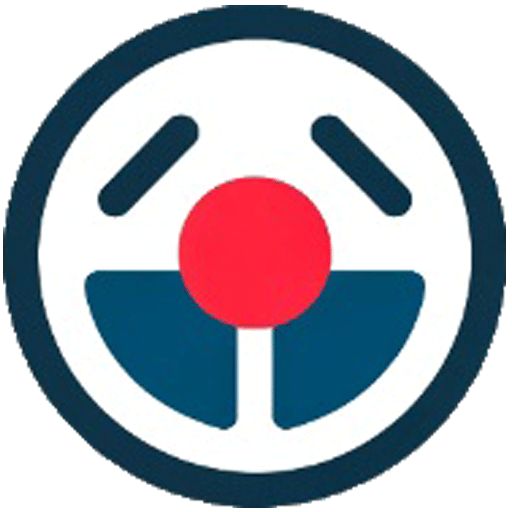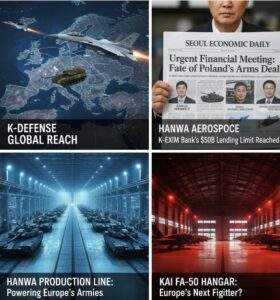Hanwha vs KAI: The Real Battle Isn’t in Europe; It’s in Seoul
To an observer in Washington or Brussels, South Korea’s ascendance as a premier arms exporter looks like a brilliantly coordinated national effort—a “K-Defense” wave systematically capturing a European market desperate for re-armament. Headlines celebrate the multi-billion-dollar deals for Korean tanks, jets, and artillery.
But from a perspective in Seoul, this is not one team. It is a high-stakes, cutthroat corporate war.
The Western narrative of a monolithic “Team Korea” misses the real story: a fierce domestic rivalry between two defense giants, Hanwha Aerospace and Korea Aerospace Industries (KAI). They are competing not just for contracts in Warsaw and Bucharest, but for political favor in Seoul, for limited state-backed financing, and for the dominant position in a European market suddenly worth over $50 billion.
This is the real battle for Europe’s arms deals, and it’s being fought as much in the halls of Korea’s government as it is on the testing grounds of NATO.
The New “K-Defense” Gold Rush: Why Europe is Buying
The war in Ukraine acted as a brutal catalyst, exposing a generation of under-investment in European defense. NATO stockpiles, particularly in artillery and armored vehicles, were depleted in months. This created a perfect storm of demand that South Korean industry was uniquely positioned to fill.
The K-Defense value proposition is built on three pillars that Western competitors struggle to match:
- Speed of Delivery: While German or American contractors quote delivery times in years, Korean factories are delivering proven, high-tech systems in months. This “production is deterrence” model is exactly what frontline states like Poland crave.
- Proven High-Tech: This is not experimental hardware. The K9 Thunder SPH and FA-50 light fighter have been battle-tested or flown for years by the Republic of Korea Armed Forces, one of the world’s most advanced militaries.
- Cost-Effectiveness: K-Defense offers near-peer NATO-compatible technology without the astronomical price tag of top-tier US F-35s or the production delays of Germany’s newest systems.
This created the gold rush. Now, we look at the two contenders racing to claim the prize.
The Heavyweight Champions: Profiling the Contenders
Understanding this conflict requires understanding the fundamental differences between the two companies.
Hanwha Aerospace: The “Total Land Solution” King
Hanwha is one of Korea’s massive family-run conglomerates, or chaebols. Its defense arm, Hanwha Aerospace, has pursued an aggressive strategy of vertical integration, most notably by acquiring Daewoo Shipbuilding (now Hanwha Ocean).
- Core Products: Hanwha dominates land systems. Its flagship is the K9 Thunder self-propelled howitzer (SPH), arguably the most successful SPH on the global market. This is complemented by the Chunmoo K239 multiple-launch rocket system (MLRS) and the next-generation Redback Infantry Fighting Vehicle (IFV).
- Corporate Strategy: Hanwha positions itself as the “one-stop-shop” for a modern army. Its pitch to nations like Poland and Romania is total partnership: “We will not just sell you tanks and artillery; we will help you build your entire domestic defense industry, integrated from land to sea.”
Korea Aerospace Industries (KAI): The “Supersonic” Challenger
KAI is a different beast. Born from a government-led consolidation of aerospace companies in 1999, it operates as Korea’s semi-public, national monopoly for fixed-wing military aircraft.
- Core Products: KAI’s global success rests almost entirely on the FA-50 Fighting Eagle. This supersonic light combat aircraft is the perfect solution for air forces needing to replace aging Soviet-era MiGs with a NATO-compatible jet—and fast. Its future, however, is staked on the KF-21 Boramae, a 4.5-generation fighter that represents Korea’s ultimate aerospace ambition.
- Corporate Strategy: KAI leverages its unique position. As the only provider of this specific, high-demand asset, it bypasses the ground-level brawls. Its strategy is to lock in air forces with the FA-50, creating a long-term pipeline for maintenance, upgrades, and a future transition to the more advanced KF-21.
Insider Analysis: The View from Seoul on Key Battlegrounds
This corporate rivalry is playing out with brutal intensity across Europe.
Poland: The Multi-Billion Dollar Proving Ground
Poland’s massive “Phase 1” contracts in 2022 were the perfect illustration of the split. The deals were strategically divided: Hanwha secured the lion’s share of land systems (K9s and Chunmoos), while KAI secured the air (FA-50s).
What analysts in Seoul are focused on now, however, is “Phase 2.” This is where the real battle lies. According to Korean financial news, the core challenge is no longer technology; it’s export financing.
Both Hanwha and KAI are desperately lobbying the Korean government to raise the lending caps of the Export-Import Bank of Korea (K-EXIM). The bank is reportedly near its legal lending limit to Poland. The company that successfully secures this state-backed financing will be the one that wins the next round of multi-billion dollar contracts.
Romania: The Next High-Stakes Showdown
Romania is the current flashpoint. It is actively seeking both new SPHs and light combat aircraft. Local Korean reports indicate that Hanwha and KAI are engaged in intense, separate lobbying efforts in Bucharest.
This is not a unified “Team Korea” push. Hanwha is leveraging its K9 victory in nearby Poland, while KAI is pushing the FA-50 as the only logical successor to Romania’s MiGs. Their efforts are largely uncoordinated, demonstrating that each is fighting for its own bottom line.
Norway, Finland, & The Nordics: A Hanwha Stronghold
Long before the Ukraine war, Hanwha had established a critical stronghold in Northern Europe. Its K9 SPH was successfully sold to Norway, Finland, and Estonia. This established Hanwha as a trusted, incumbent partner in the region, giving it a significant advantage in any future land system procurements. KAI, by contrast, has struggled to penetrate a Nordic market heavily dominated by the US (F-35) and Sweden’s (Gripen).
The “Seoul Insider” Angle: What Western Media Misses
To fully grasp the stakes, one must look past the hardware and at the dynamics within South Korea itself.
This Isn’t “Team Korea”—It’s a Fierce Corporate War
The “K-Defense” brand is a powerful marketing tool for a global audience. But from a perspective in Seoul, it’s a fiction.
Hanwha and KAI are engaged in a fierce war for the same limited resources. They compete for top-tier engineering talent from Korea’s elite universities. They battle for the same government R&D support from the Ministry of National Defense (MND). And as the Poland case shows, they are locked in a zero-sum political fight for the limited pool of state-backed export financing that makes these mega-deals possible.
The Political & Corporate Subtext
Understanding this corporate dynamic is key. Hanwha, as a private chaebol, is aggressive, M&A-driven, and answers to its shareholders. It moves with a speed that state-owned enterprises cannot match.
KAI, as a semi-public entity (state-run banks are major shareholders), is more politically sensitive and its fate is often tied to the national political agenda. It benefits from its “national champion” status in aerospace but can be constrained by bureaucracy.
These two companies lobby the Yongsan presidential office and the MND with entirely different narratives, each positioning itself as the more critical strategic partner for Korea’s economic and security future.
Strategic Verdict: Who Has the Long-Term Edge for the $50B Prize?
So, who is better positioned to win the lion’s share of the next $25 billion in European contracts?
- Hanwha’s Edge: A highly diversified portfolio (land, sea, air, and space), deep financial reserves from its conglomerate structure, and a proven, scalable “production is deterrence” model that is exactly what the market demands.
- KAI‘s Edge: A powerful niche monopoly in the high-demand light combat aircraft sector. The FA-50 has few, if any, true competitors in its class. Its long-term value is tied to the success of the KF-21, which, if successful, will elevate KAI to an entirely new class of global exporter.
The final assessment from Seoul is this: The winner of this $50 billion war will not be decided by technology or firepower alone.
The victor will be the company that best navigates the complex financial and political landscape in Seoul. The deciding factor is which contender can more effectively secure the political and, most importantly, financial backing from the Korean government to underwrite these massive European deals. This, more than any product spec sheet, will determine the true king of K-Defense.
Hi, I’m [jeybee]. As a long-time resident of Seoul, I’m passionate about uncovering the authentic, everyday magic of Korea. This blog is my way of sharing my favorite spots, tips, and cultural insights with you, beyond the usual tourist traps.


